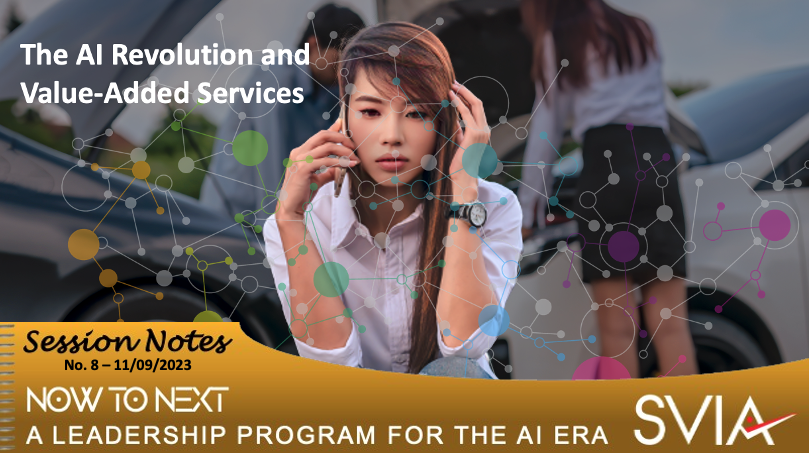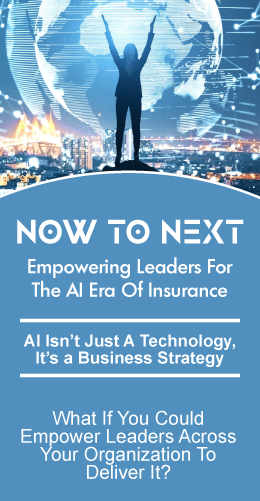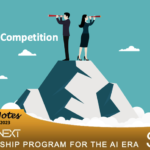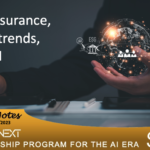
P&C insurance’s competitive landscape is shifting rapidly as companies compete to offer value-added services beyond traditional coverage. The arrival of AI-native consumers—reshaping expectations in the wake of ChatGPT’s explosive growth to over 180 million users—is about to accelerate this trend and deepen it’s competitive impact.
Pivoting to these new consumer expectations mandates the strategic integration of AI, ML, and LLMs into service offerings. The market now demands a recalibrated approach to value, emphasizing ease, personalization, and alignment with consumer values. Staying competitive means actively embedding AI into our value-added services strategy, positioning our services to successfully navigate the incoming wave of AI-enhanced competition.
Primary Factors:
P&C insurers are rapidly diversifying their offerings beyond mere risk coverage. They are innovating across several fronts to provide value-added services that address the wider needs of their customers. Here’s a closer look at the most impactful value-added services currently shaping the market:
- Home Security and Automation: Insurers offer discounts on security systems and smart home devices, positioning themselves as protectors of the home and assets.
- Maintenance and Repair Services: From plumbing to HVAC maintenance, insurance companies are embedding home upkeep into their services, emphasizing a preventative stance on risk management.
- Energy Efficiency and Sustainability: Insurers are not just insuring against environmental risks but also aiding customers in adopting a more sustainable, energy-efficient lifestyle with audits and discounts on eco-friendly appliances.
- Disaster Preparedness and Recovery: Insurers provide resources for disaster readiness and quick recovery, aligning with the increasing frequency of climate-induced catastrophes.
- Telematics and Safe Driving Incentives: Through telematics, insurers encourage and reward safe driving, actively contributing to reducing road mishaps.
- Identity Theft Protection and Cybersecurity: Reflecting the digital age’s new risks, insurers offer services to safeguard personal data, offering support that goes beyond traditional insurance boundaries.
- Roadside Assistance and Vehicle Upkeep: Extending aid in real-time during on-road emergencies or routine car maintenance, insurers enrich the value proposition of their auto insurance policies.
- Usage-Based Insurance Models: UBI personalizes premiums, rewarding good behavior while gathering valuable data for insurers.
The Transformative Impact of AI on Value-Added Services
The integration of AI, ML, and LLMs is redefining these value-added services by introducing a new level of personalization, prediction, prevention, and efficiency. Here’s how AI is enhancing these services:
- AI can process and analyze data from multiple sources in real-time, making risk assessment more dynamic and context-sensitive.
- AI-driven services can proactively address risks, utilizing IoT and real-time data to prevent damages or expedite claims processes.
- AI enables hyper-personalization by understanding individual user behaviors and preferences offering tailor-made solutions and interactions.
- In the event of claims, AI can orchestrate a coordinated response across multiple service providers, significantly shortening the resolution time.
- By aggregating data from various aspects of users’ lives, AI creates comprehensive risk profiles that inform better decision-making for underwriters and customers.
A Future Forward Scenario
Imagine a California Institute of Technology student, Emily, who is en route to her final exams when she experiences a minor car accident. Her vehicle is undriveable, and she’s stranded, with the clock ticking down to her exam time. This is where an AI-enhanced insurance service springs into action, demonstrating the real-world benefits of such technologies in value-added services:
Upon impact, her car’s telematics system alerts her insurer’s AI platform. Simultaneously, it gathers and transmits all relevant data — including vehicle diagnostics, time, location, and driving conditions leading up to the accident. The AI requests access to nearby traffic camera feeds, using image recognition to assess the situation and confirm details for the insurance claim. It also scrapes public databases for the other party’s vehicle registration details, cross-referencing it with insurance records to facilitate a swift resolution.
The AI system instantly communicates with Emily’s chosen auto repair shop, relaying accident details and arranging immediate towing services. It also drafts an initial repair estimate based on the uploaded images of her damaged vehicle and historical data on similar incidents. Recognizing the urgency of Emily’s schedule, the AI system hails an Uber to pick her up from the accident scene and take her to Caltech in time for her exam. It also sends a notification to her professor explaining the situation and requesting leniency in her exam grading due to unforeseen stress.
Behind the scenes, the AI is already compiling a comprehensive insurance claim report. It schedules a virtual meeting between Emily and the insurance adjuster post-exam and initiates pre-authorization for potential repairs. The AI analyzes the damage and immediately predicts the required repair parts, sourcing them from cost-effective providers and placing orders pending the repair shop’s approval. As the repair shop provides its assessment, the AI compares it with its predictive model, suggesting optimal repair methods. It fine-tunes its strategy based on the shop’s feedback, ensuring all actions align with insurance policy stipulations. The AI arranges a rental car for Emily, ensuring delivery to the campus and securely sending the necessary instructions and access codes to her smartphone while her car is repaired.
This hypothetical scenario showcases the future of AI in enhancing the value-added services offered by P&C insurance companies. It’s about covering the risk and providing a comprehensive, seamless support system that practically addresses the customer’s needs in real-time, pivoting from a reactive to a proactive and preventive service model.
Key Takeaways:
Strategic AI Integration Elevates Value-Added Services: AI’s deep integration into value-added services sets a new competitive bar, fundamentally redefining how insurance companies deliver customer value and differentiate themselves in the market.
- Real-time Data Synthesis and Action: AI’s ability to process and act upon data from diverse sources in real-time, as in post-accident scenarios, exemplifies the shift towards dynamic and responsive customer service.
- Risk Management Becomes Predictive and Personalized: With AI, risk management evolves from reactive to proactive, tailoring strategies to individual profiles and live data feeds.
- Customer Experiences Are Hyper-Personalized: The move towards hyper-personalized services, informed by AI’s analysis of personal behaviors and preferences, is rapidly becoming a mainstay of competitive strategy.
- AI Facilitates Integrated Response Systems: The interconnectedness of AI systems across various services, providing streamlined solutions like in Emily’s case, showcases the compound value of integrated service offerings.
- Accelerating the Claims Process: AI’s facilitation of speedy claims processing by coordinating between different services and stakeholders represents a leap in operational efficiency and customer satisfaction.
- Operational Transparency as a Trust Builder: Using AI to keep stakeholders updated ensures operational transparency that strengthens customer trust and loyalty.
- Resource Management Optimization: AI’s capacity for optimizing logistics and resource allocation underscores its role in enhancing the efficiency and sustainability of insurance operations.
- Driving Sustainability Through Smart Analytics: AI reinforces an insurer’s commitment to broader societal objectives by aligning service offerings with customer values and sustainability goals.
- Value-Added Services as Competitive Imperative: The deepening role of AI in reshaping value-added services marks them as enhancements and essential components of an insurer’s competitive toolkit.
Critical Questions:
- How are we integrating AI to enhance our value-added services? Consider whether your current strategy leverages AI’s full potential to enrich customer services and experiences.
- What data sources are we tapping into to drive AI-based personalization? Evaluate the diversity and quality of your data to ensure your AI tools can deliver truly personalized services.
- Are our AI implementations designed to be adaptive and context-aware in real-time scenarios? Assess if your AI systems can make autonomous decisions in a customer’s moment of need, much like in the case of a student involved in an accident.
- How does our AI strategy align with customer-centric values and sustainability goals? Reflect on whether your AI systems are aligned with not just business outcomes but also the values and ethical standards expected by your customers.
- What measures are in place to ensure operational transparency in our AI-driven processes? Consider whether you have the necessary processes to maintain transparency, which is crucial for building trust in AI-driven operations.
- Do we have a framework for continuous learning and improvement in our AI systems? Determine if you have established mechanisms for your AI to evolve from customer and operational feedback.
- Are we prepared to handle the increasing complexity of claims with AI technology? Gauge your current capabilities to manage multifaceted claims efficiently using AI and identify gaps in technology or process.
- What partnerships and collaborations are we fostering to innovate our AI-driven services? Consider the partnerships that could propel your AI capabilities forward and whether you’re effectively leveraging these relationships.
- How are we preparing our workforce for an AI and data-analytics-driven future? Deliberate on the training and development initiatives you have in place to skill your workforce for new AI technologies and methodologies.
- What steps are we taking to ensure our AI strategy is resilient against evolving cyber threats? Consider the cybersecurity measures integrated into your AI infrastructure to protect against potential breaches and data theft.
Executive Actions:
- Assess and Enhance Data Capabilities: Audit current data collection and processing capabilities to ensure they can support advanced AI functions. If gaps are identified, prioritize their bridging—this may include investing in data infrastructure, such as secure cloud storage and advanced data analytics tools.
- Develop an AI Integration Roadmap: Create a comprehensive roadmap for AI integration across all value-added services. This should outline short-term and long-term goals, resource allocation, timelines, and expected outcomes.
- Foster a Culture of Innovation: Encourage a company culture that embraces change and innovation. Support initiatives that drive AI adoption and create a safe space for experimentation and learning from failures.
- Train and Upskill Staff: Implement training programs to ensure teams are proficient in AI and analytics. Consider hiring or partnering with AI experts to accelerate your learning curve and integration process.
- Ensure Regulatory Compliance and Ethical Standards: Keep abreast of regulatory changes and establish internal policies to ensure AI compliance and ethical use, particularly concerning data privacy and consumer protection.
- Prioritize AI Security Measures: Upgrade cybersecurity protocols to safeguard against the increased risks associated with AI and data analytics. This includes regular security audits and adopting state-of-the-art security technologies.
- Leverage AI for Personalization at Scale: Use AI to deliver personalized services at scale, such as customizing insurance plans or giving individualized risk assessments, using real-time data analytics.
- Invest in Customer Experience Technologies: Allocate budget and resources towards technologies that enhance customer experience, such as AI-powered chatbots, personalized apps, and omnichannel support systems.
- Engage in Strategic Partnerships: Seek strategic partnerships with tech companies, startups, and academic institutions to stay at the cutting edge of AI developments and gain early access to new innovations.
- Monitor and Adapt AI Performance: Set up monitoring systems to regularly assess the performance of your AI implementations and adapt them based on feedback and new data to improve accuracy and user experience continuously.
The accelerated adoption of AI in P&C insurance isn’t just an evolution—it’s a revolution. The steps we take today to integrate AI into our value-added services will define our competitive edge tomorrow. I







